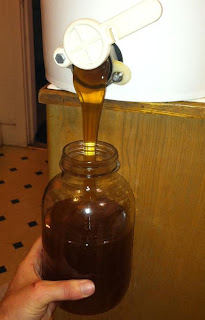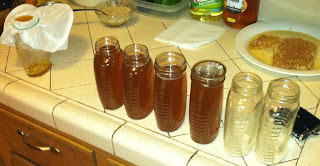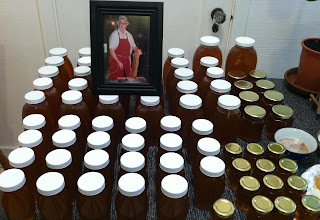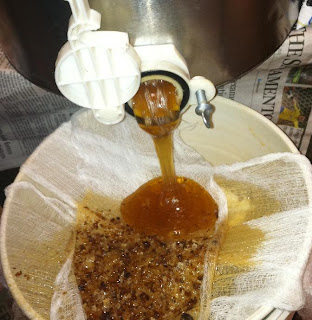This is how it all starts. A honeybee extracts nectar from a flower. Brings it back to the hive. 20,000 of them work day in day out, and produce honey and honeycomb in the hive all year round. They will fight and they will die to protect their honey and their hive. It's a beautiful, wonderful process.
But this entry is not about the birds and the bees. It's about a great man from Davenport, Iowa who harvested his own honey, and taught his sons how to do it, too. And of his 11 sons and daughters, the youngest has carried on the tradition, all the way out here in Midtown, Sacramento of California.
He does not wear a veil. He does not wear gloves. Just like his father. He goes out to the hive in the backyard and softly talks to the bees, as he gently smokes them with burning burlap. He brushes them carefully from each frame. He tells the bees that he is not there to hurt them. Sometimes he'll hum them a sweet tune. The bees relax.

After carefully removing each frame from the hive and gingerly bringing them into the house, the extraction process begins.
Here is the equipment you will need:
A couple of buckets with faucets, an extractor, an electric heated knife, newspapers to cover the kitchen floor, and lots and lots of jars. You will also need a strainer, cheese cloth, and a spoon.
First you must cut the caps off the combs in the frames. The bees do a great job of "capping" their honeycomb and sealing them tightly shut so the honey doesn't leak out.
Next, you place the frames (two at a time) in the extractor, and spin as hard and as fast as you can. All the honey will fly out of the combs and settle at the bottom of the extractor. Then, you will turn the faucet on, and let the honey pour into a big bucket.


You will make sure to strain it through a fine cheesecloth so you make sure to filter out all the bee wings and other wax particles from the honeycombs.
After filtering once or twice, there may be foam gathered at the top of your bucket on the honey. Paul lovingly scoops out the foam by hand and makes sure that the honey is good and pure.


He then begins to pour the honey into big jars so that they can be heated (to about 120-145 degrees) in boiling water.


After heating them, you can pour them into smaller jars, again through a strainer or cheesecloth to filter them once more.


These jars that he is using are from his father. His father mailed them to him over 10 years ago, before he passed away after learning that Paul has taken up beekeeping. He sent his blessings in a carefully wrapped box with jars, burlap, and a Beekeepers magazine.
This batch is dedicated to his father and his mother who just passed in August. She would have loved a jar of this year's honey. We were able to harvest 57 pounds of honey this year. It was hard work and Paul spent many nights staying up into the wee hours of the morning to heat the honey, jar the honey, filter the honey, and label the jars. It is truly a labor of his love.

I am honored and touched to have witnessed this process and lend a hand to the harvesting of this honey. We are happy to share our honey with family and loved ones, and hope that if you received a jar of honey from us, please know that it comes with hours of labor and love, and that we sincerely hope you enjoy it.




Hi Paul,
ReplyDeleteI really enjoyed reading that, I never knew what went into beekeeping and extracting honey, It was truly facinating. I think that was a great way to honor your parents my great-grandparents.
WOW I am really amazed. Great pictures. Sweet story (no pun intended)
ReplyDelete